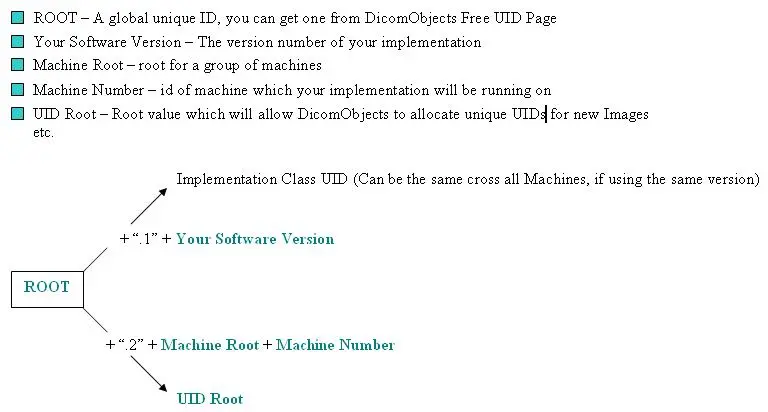ImplementationUID and ImplementationName
The Implementation Identification information allows implementations of communicating AEs to identify each other at Association establishment time. It is intended to provide non-ambiguous version identification in the event of communication problems encountered between two nodes.
This information only relates to the software on the machine, not the machine itself, so it is perfectly permission and normal for multiple pieces of equipment to have the same values.
This should be contrasted with objects (such as images) created in DICOM which must have unique UIDs, and therefore, to guarantee this, each piece of such equipment must have a unique “root” from which to derive such unique UIDs. For DicomObjects this is most conveniently places in the UIDRoot Registry value which then enables it to be used by the DicomGlobal.NewUID COM/.NET method.
Implementation Identification provides on two pieces of information:
- Implementation Version Name (Optional)
- Implementation Class UID (Required)
Implementation Version Name
Not mandatory, maximum length is 16 characters. This optional field is purely there to provide a human readable form of the information.
- Default Implementation Version Name in DicomObjects.COM
The default value for DicomObjects.COM-based implementations is DCMOBJw.x.y.z where x, x, y & z are the components of the version number.
- Default Implementation Version Name in DicomObjects.NET
The default value for DicomObjects.NET-based implementations is DicomObjects.NET.
Implementation Class UID
Mandatory, maximum length is 64 characters, including “0”-“9” and “.”. This field should identify in a unique manner a specific version of the implementation, which would normally be the same on multiple machines.
Here is our suggestion:

To get free ROOT UID, please go to DicomObjects Free UID Page.
For more information about UIDRoot, check it at the registry values page.